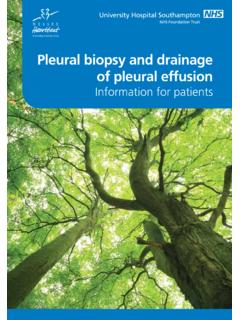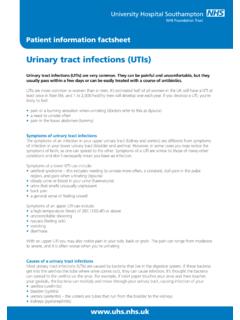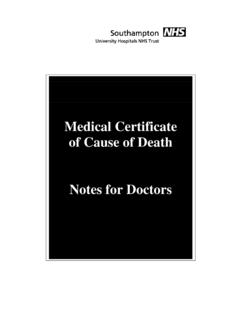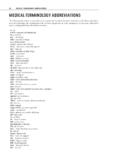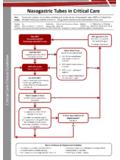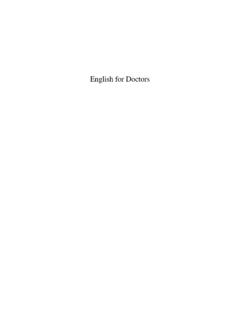Transcription of Discharge advice following nasal surgery patient …
1 patient information factsheetDischarge advice following nasal surgery There are several types of nasal surgery , for which Discharge advice tends to be the same. The following describes the most common procedures undertaken on F5 resection is an operation to straighten the nasal septum, by removing some of the cartilage and is an operation to straighten the nasal septum by mobilising it and repositioning it in the is an operation to straighten the nasal septum (septoplasty) and correct any bony deformity. The nose is stabilised with an external plaster or under anaesthetic (MUA) is an operation to repair a broken nose by repositioning, as much as possible, the fractured bone into its original position. The nose is then stabilised with an external plaster or diathermy is an operation to remove nasal blockage and improve nasal breathing, achieved by shrinking the mucosa lining the nasal turbinates (curved shelf-like structures made of bone and tissue that run along the inside of the nose).
2 Diathermy is an electrically-heated instrument that cauterises the unwanted is an operation designed to trim or remove excess tissue from the nasal turbinates (curved shelf-like structures made of bone and tissue that run along the inside of the nose) and aims to improve nasal endoscopic sinus surgery (FESS) aims to restore normal functional drainage of the sinuses. Very narrow telescopes (endoscopes) are used to examine the nose and sinuses and fine instruments are used to remove any unwanted bone or antrostomy is an operation to make a new opening from the nasal cavity into a blocked sinus, so allowing the sinus to drain polypectomy is an operation to remove any polyps from the inside of your nose. Polyps develop from the mucous membranes, particularly in the sinuses, and appear as grape-like swellings that block the nose and affect the sense of smell.
3 Polyps can grow back of a septal haematoma is an operation to drain a collection of blood, which can be infected, that lies between the septal cartilage and the mucous membrane of the does the operation consist of? The operation is carried out under general anaesthetic and usually takes 30-60 minutes. The majority of surgery is done within the nose so there are no visible scars. Small dressings may be placed inside the nose. These are called packs and their function is to keep things in place and reduce bleeding. Your nose will therefore feel blocked, and so you will breathe information your mouth, which may then feel dry. A small outer dressing (bolster) sits under your nose and this collects any ooze from the packs. Any packs usually stay in place for four to 24 hours and the surgeon will instruct when to take them out.
4 You will wake up in the recovery area of the theatre department and be closely monitored by the nursing staff. You will be given any medication to relieve any pain or happens back on the ward? Upon return to the ward, you will need to rest in bed, as you may well feel sleepy from the anaesthetic. It is strongly advised not to leave the ward area as you may feel unwell. Your condition will continue to be monitored with any medication to keep you comfortable. The outer dressing (bolster) will be changed as needed. It is normal to have some ooze or bleeding, as the nose has a very rich blood supply. Resting in bed on the ward will minimise any risk of bleeding. A heavy bleed sometimes happens and will be treated with ice. Fluids and a light diet can be taken as soon as you are feeling able.
5 Using a straw to drink may make this easier, as sometimes you can experience a sucking sensation whenever you swallow. This is due to the effects of any swelling or any nasal packing. This settles usually by the next day. If you have an external plaster or splint, this will be secured in place with tape and stays in place for one to two weeks. This supports the nasal bones in their new position and must be kept dry. Discharge advice Your doctor will advise you on a specific period of recovery but in general rest for one to two weeks. If you need a sick certificate, please ask the medical staff before you leave. The nose will feel blocked due to post-operative swelling and can take a few weeks to settle down. If prescribed, apply any nasal drops/spray to decongest the nose and follow the recommended method of installation.
6 You may have a blood-stained watery Discharge from the nose. This is normal and should settle after a few days. Scabbing within the nose may occur as it heals. Do not pick this off as the area will bleed. You may have been advised to douche (rinse) the nose and the nursing staff will advise you on the correct technique. For the first few days, avoid very hot drinks, meals, baths or showers. For one week, avoid blowing your nose and sneeze with your mouth wide open. These all help to reduce any risk of bleeding. Avoid or cut down on smoking as smoking affects the body s ability to heal and irritates the inside of the nose. Staff can advise you on quitting, provide you aids to help you quit ( , nicotine patches) and contacts for support groups.
7 Avoid crowded or dusty places and people with coughs and colds, as infection can be picked up in the nose. If nasal splints or a plaster are in place, do not touch and attend the arranged outpatients appointment for their removal. Avoid contact sports for four weeks due to the risk of trauma and bleeding. If fresh, steady bleeding occurs, pinch the fleshy part of the nose, lean forward and apply ice to the forehead and bridge of nose. A frozen bag of vegetables is a good alternative if you don t have ice in the freezer. Avoid swallowing any blood as it can make you feel sick. If the bleeding does not stop after 30 minutes, ring the ward for F5 ward if you have any concerns following Discharge or if you experience any of the following : Uncontrollable bleeding from the nose Raised temperature Pus-like Discharge (yellow-green) from the nose Increased painPatient information you need a translation of this document, an interpreter or a version in large print, Braille or audio, please call 023 8120 4688 for informationF5 ward: 023 8120 6511 023 8120 4644 NHS 111: 111 Version 1.
8 Published March 2013. Due for review March 2016.


